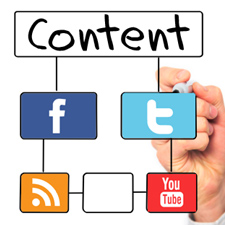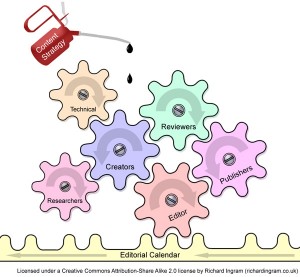As every good digital or online person knows, your marketing campaign is only as good as the landing page you send people to. So when I started in a new role and had to build a digital strategy, online marketing and communications plan and build a new website, I took a deep breath and started with the website content.
Website content has now been one of the primary focuses of my professional life for the past 20 months. When I started planning the website content strategy and navigation structure, I had to sit down and think about where to start. Its easy to look at an organisation from the inside out, its much harder to look at it from the outside in, as a consumer, a customer, a supporter or a donor might. But I had the benefit of being new to WWF and my perspective still was that of an outsider. So I used this to my advantage as best I could.
I started by identifying the gaps in our current website content (wwf.org.au)- there were a lot. Then I started looking at our competitors (Greenpeace, ACF, WSPA, RSPCA etc) and our common content themes (palm oil, climate change, biodiversity, deforestation) and researching where we all ranked in Google’s search listings. I found a lot more gaps, for us, but also opportunities that none of the organisations were optimised well for (Indigenous Partnerships, Cockatoos, Biodiversity etc).
I took note of all these things and I started a draft information architecture (fancy word for site navigation and URL formulas). We had to reshape the site from the 2005 vision to match our 2010/11/12 global priorities and conservation work plans. This is where the internal negotiations began. We did some focus group research with supporters and non-WWF supporters and got the outside in point of view. We had to understand what terminology they understood and what was too technical, scientific or complex. We identified key themes, labels and keywords that our supporters and non-supporters thought were synonymous with the WWF brand.
Then we had to do some consultation with our internal stakeholders, who predictably, look at the website from a point of view of replicating our internal work. So I had to change their thinking and make them see the website as an interactive, engagement tool for the user, or the donor, not as a broadcast channel for an organisation. It took a while but we were able to come to some compromises where we reflect some of our internal strategies, programs, language and structures whilst still meeting the users expectations and offering a few extra pieces of content that will serve the users needs only – research, answers to questions and curiosity.
So now the real work began. We had to review, redraft and write from scratch every single page on the website. We had to identify which pages, sections, topics would be archived and which would carry forward to the new and improved WWF.org.au. We then had to write all the content to fill in the many gaps we found. WWF’s strength is its people and its knowledge. We have some incredibly start, interesting and knowledgable people – some of these people are leader WORLD experts in their field of climate change adaptation or botany or ecology or a specific species of macropod (from the kangaroo family).
So I needed to harness this power and enthuse these scientific experts to take time out of the job of conserving the environment and all living things in it, to write down what they do. As I mentioned, they are scientific minds, and we’re talking about hundreds of pages from dozens of writers, so we needed a process. Once the draft content was supplied by the conservation expert, the marketing team needed to review and edit it and make sure that the words weren’t too big, that the science wasn’t too complex and that an average user could consume the information easily. Then it had to go back to the conservation author to make sure that we hadn’t edited out the scientific integrity of the information, and that all of the content was accurate and correct. Then it had to have all of the user friendly elements added to it – known as engagement objects; headings and sub-titles, images, infographics, videos, related links to other pages etc.
Once we had it in a format that we were happy with, it went to a proofreader and editor to make sure that it was all in the same tone of voice. This content was written by dozens of people, who all have their preferred language. We needed to ensure that all of the content across the site used consistent terminology throughout, that the keywords we had identified for each of the SEO silos had been maintained throughout the text, and of course that it was grammatically correct. Then it went to a conservation expert for a final read through to ensure that the scientific integrity was in place. There were over 250 pages just in the conservation part of the website, and a further 250+ in the news, about WWF and What you can do (supporter) sections.
And so here we are, approximately 9 months later and the final website content, after at least 4 rounds of approvals, fact checking, proofreading and editing and with a user experience eye cast over it, we are in our final stages of approval. The Conservation Director of WWF Australia will herself review every page of the website before we “go live”.
Every digital marketer, every website or online manager, every content person, every digital/ online producer should tell you, that in our world, Content is King! If you have good content, the people will come, and they will come back, again and again. If you have good content, search engines will find you and send people. If you have a good click through rate (CTR%) and a strong quality score from Google and if you’re page rank is getting better and better, Google will increase your rank in the search listing to reward you for supplying good content to their users.
(Deep Breath) AND THEN …. you have to connect it to your external communications and social media strategy because this is how you’re going to start promoting your new website content.
 It is important to also remember that website content is a long term strategy. It needs to be reviewed, maintained, optimised, updated, fact checked, archived, refreshed on a regular basis. Website content should not be a set and forget. It will last you a while when you do it all properly, but if you don’t maintain it (as the image above shows – a well oiled machined), then you’re going to have to go through the same painful process I have outlined here, every few years. A little maintenance on a regular basis will reward your bottom line as well as your customer experience.
It is important to also remember that website content is a long term strategy. It needs to be reviewed, maintained, optimised, updated, fact checked, archived, refreshed on a regular basis. Website content should not be a set and forget. It will last you a while when you do it all properly, but if you don’t maintain it (as the image above shows – a well oiled machined), then you’re going to have to go through the same painful process I have outlined here, every few years. A little maintenance on a regular basis will reward your bottom line as well as your customer experience.
In the digital world, you can have the best online marketing strategy, paid search campaign, email campaign, online display advertising campaign – they could all be sending 500,000 people a month to your website, but if, when they get there, the user has a bad experience, it’s all for nothing. Remember, Content is King!


I didn’t know that.